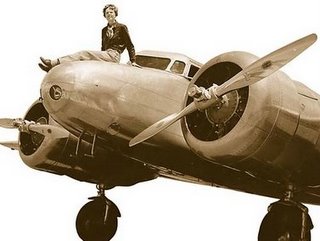
I don't know what to think of people who risk their lives for a thrill or notoriety, like Earhart, or the guy who jumped his motorcycle over a canyon, Evel Knevel, and Lindberg. But they make our lives interesting none the less. Here is a chronicle of her last stunt in 1937, written by Keri Rumerman.
What turned out to be the final flight of Earhart's career, and, ultimately, her life, began on June 1, 1937. Earhart and Noonan left for their round-the-world flight from Miami, Florida, in her twin-engine, red-winged Electra. From Miami, they flew to San Juan, Puerto Rico. Right before taking off on this leg of the flight, Earhart was quoted as saying, "I have a feeling there is just about one more good flight left in my system and I hope this trip is it. Anyway, when I have finished this job, I mean to give up long-distance 'stunt' flying."
As Earhart's journey continued, news of her flight made the front page of newspapers around the world. She sent reports of the land, cultures, and people she encountered. On June 30, 1937, Earhart and Noonan arrived in Lae, New Guinea. They had traveled 22,000 miles (35,406 kilometers) and had 7,000 miles (11,265 kilometers) left to go.
Their next destination, and the most dangerous stop of the trip, was Howland Island, a tiny island in the Pacific Ocean, 2,556 miles (4,113 kilometers) away. Before Earhart took off from Lae on July 1, there was confusion about which radio frequencies were to be used, which remained unresolved before she took off. As the scheduled time neared for Earhart to approach the island, several transmissions were received from her, demanding to know the weather. A new weather report describing heavy clouds and rain northwest of Howland had been issued, and Earhart had apparently run into the storm. Earhart transmitted several more times but never reached her destination, disappearing somewhere off the coast of the island. A large search party was quickly organized, but no remains of the crew and the plane were ever found.
There are many theories surrounding the controversial disappearance of the plane on July 2, 1937. The most commonly accepted theory is that the fliers got lost, ran out of gas, and went down somewhere in the Pacific Ocean. However, as war between the United States and Japan was imminent, there were rumors that Earhart had been on a spy mission for the United States and was supposed to photograph Japanese military installations. This theory says that she crash-landed and was captured by the Japanese, who imprisoned or executed her. A third theory was that her disappearance was staged to allow the U.S. Navy to conduct a search in the South Pacific.
Although only 39 when she disappeared, Earhart accomplished a great deal and is considered a true hero of the 20th century, especially for women. She demonstrated courage, integrity, and an independent spirit. She used her fame to advance the cause of women and showed that a determined woman could achieve anything. Her efforts led a generation of women to seek new horizons and new roles for themselves.
--Keri Rumerman
No comments:
Post a Comment